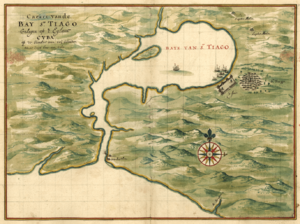Raid on Santiago de Cuba (1603) facts for kids
Quick facts for kids Capture of Santiago de Cuba |
|||||||
|---|---|---|---|---|---|---|---|
| Part of the Anglo–Spanish War | |||||||
 Map of the Bay of Santiago de Cuba |
|||||||
|
|||||||
| Belligerents | |||||||
| Commanders and leaders | |||||||
| Pedro de Valdés | Christopher Cleeve | ||||||
| Strength | |||||||
| Militia & fortification | 2 ships 200 |
||||||
| Casualties and losses | |||||||
| 4 vessels burned | Unknown | ||||||
The Capture of Santiago de Cuba was a small but important event during the Anglo-Spanish War. In May 1603, English privateers, led by Christopher Cleeve, attacked and took over the city of Santiago de Cuba.
The Attack on Santiago
Planning the Raid
In early 1603, a man named Christopher Cleeve left England. He was on a special mission to raid Spanish lands. Cleeve sailed with his large armed merchant ship, the Elizabeth and Cleeve. He also had a smaller ship called a pinnace. Many London merchants helped pay for this trip.
Cleeve reached the Caribbean in April. His main goal was Santiago de Cuba. This city had not been attacked by the English in a long time. Santiago de Cuba was the second biggest town in Cuba. It was founded way back in 1515. Pirates and privateers had attacked it before, like in 1553.
The Raid Begins
On May 12, 1603, the English ships landed in a bay near Santiago de Cuba. They did not face any fighting at first. They quickly took over a small fort. This fort was not even finished yet. They also captured a special wall called a ravelin and a gun battery. These defenses were on the beach.
Cleeve's men then marched towards the town. They launched a surprise attack. The local soldiers tried to fight back. But they were quickly defeated. The English then entered the city. They began to take valuable items. Many buildings were robbed. This included the main church, the Cathedral Basilica of Our Lady of the Assumption. The English gathered a lot of treasure.
City Occupied
The English stayed in the city for a few days. They tried to get the city to pay a ransom. This meant they wanted money to leave the city alone. But no one paid them. So, Cleeve ordered his men to set fire to many buildings. The cathedral was also burned.
All the city's defenses were torn down or destroyed. Four ships in the harbor were robbed and burned too. Most of Santiago de Cuba was ruined. The English left with their treasure. They were not bothered as they sailed away. They had been in the city for less than a week.
What Happened Next?
After Santiago, Cleeve went to Jamaica, which was also Spanish. But he left because there was not much food or treasure there. On his way back home, he sailed past Cuba. On August 28, he caught two small Spanish ships. These ships were carrying the new Spanish governor of Florida, Pedro de Ibarra. Cleeve took the governor as his prisoner.
The attack on Santiago was the last big English raid on the Spanish Main. This was after almost thirty years of fighting. Soon after, King James I of England ordered all privateers to stop. Peace talks with Spain were happening in London. These talks led to the Treaty of London.
The English came back to Santiago in 1662. This time, Christopher Myngs led the attack. The city was destroyed again. The strong fort, the Castillo de San Pedro de la Roca, was also ruined.

